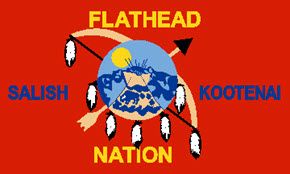The Salish in the greater Northern Plains region includes the groups called the Flathead and the Pend d’Oreille. Flathead and Pend d’Oreille are two groups with generally overlapping territories who both speak dialects of the Salish language group. Salish speaking people are generally settled west of the Rocky Mountains, from eastern and central Washington to the Pacific Coast. The Flathead represent those with the eastern-most dialect.
Originally the Flathead occupied the area now encompassed by Yellowstone National Park in northwestern Wyoming and southern Montana, and eastward as far as present-day Billings, and west from these Missouri River Basin areas to the continental divide. Although the two traditionally overlapped across much of their territory, divergent from the Flathead, the Pend d’Oreille generally settled west of the continental divide with a social and cultural center around Flathead Lake. The Flathead tend to settle more towards the eastern end of the Salish territory and Montana’s Pryor Mountains. Regular migration in search of resources was common among the Flathead, mostly aligned with seasonal cycles (Brunton 1998; Fahey 1974). (Figure 12)
 Lewis and Clark first encountered the Flathead and Pend d’Oreille while they were settled on the Bitterroot River in Western Montana. By that time, western diseases such as smallpox had already occurred westward along trade routes and had afflicted these tribes. Periodic waves of disease from the 1770s through the 1850s continued to impact the two tribes. Along with disease, trade with Europeans introduced horses, which the Flathead and Pend d’Oreille acquired by the late eighteenth century. The introduction of the horse expanded the range of the tribes, which led them farther east onto the Plains. While this allowed them to hunt bison more efficiently, it also led them into direct conflicts with neighboring tribes, especially the Blackfeet who were also expanding their range. These conflicts were costly for the Flathead and Pend d’Oreille, and they began to withdraw westward, even abandoning some camps along Flathead Lake. By the mid nineteenth century their use of the Plains was limited to seasonal trips for hunting bison (Brunton 1998).
Lewis and Clark first encountered the Flathead and Pend d’Oreille while they were settled on the Bitterroot River in Western Montana. By that time, western diseases such as smallpox had already occurred westward along trade routes and had afflicted these tribes. Periodic waves of disease from the 1770s through the 1850s continued to impact the two tribes. Along with disease, trade with Europeans introduced horses, which the Flathead and Pend d’Oreille acquired by the late eighteenth century. The introduction of the horse expanded the range of the tribes, which led them farther east onto the Plains. While this allowed them to hunt bison more efficiently, it also led them into direct conflicts with neighboring tribes, especially the Blackfeet who were also expanding their range. These conflicts were costly for the Flathead and Pend d’Oreille, and they began to withdraw westward, even abandoning some camps along Flathead Lake. By the mid nineteenth century their use of the Plains was limited to seasonal trips for hunting bison (Brunton 1998).
In 1855, the Governor of Washington Territory, Isaac Stevens, began to negotiate with the Flathead, Pend d’Oreille, and one band of Kootenai to establish a reservation along Flathead Lake, and open up the remainder of their territory for white settlement. The Flathead objected to losing access to the Bitterroot River valley. The Flatheads were initially granted a reservation along the Bitterroot River, but by the 1870s, under mounting pressure from white settlers, the U.S. government relocated the Flathead to the reservation along Flathead Lake (Fahey 1974).
The Flathead and Pend d’Oreille who were living on the Plains east of the Continental Divide hunted bison. Prior to the acquisition of the horse, bison hunting involved the use of drive lanes along with jumps or corrals to retain the bison where they could be killed. Similar methods were used in the mountain regions for antelope and deer. The horse made many of these methods obsolete, providing for more direct approaches to the herds via horseback. Other game sought included moose, rabbits, ground hogs, mountain goats, and bears, which were hunted using nets, snares, and deadfalls. Fish were an important resource to the Pend d’Oreille; this was less so for the more Plains-oriented Flathead (Brunton 1998).
Plant foods utilized by the Flathead and Pend d’Oreille also played an important role both in their diet, shelter, and tools. Bitterroot was one of the most important utilized plants, serving as a dietary staple. Serviceberries, elderberries chokecherries, and huckleberries were also eaten, often dried and pounded into cakes. Berries did not tend to be combined with meats as they were with many of the Plains tribes (Brunton 1998).
Religious views focused on communication with spirits, which could take human form or appear as animals or even inanimate objects. Of these figures, the most important was the Coyote, from whom the Flathead believe they are descended (Fahey 1974). Individuals could seek power from the spirits through vision quests; although, in some cases spirits arrived unsought. Powers provided by the spirits were not specific to the animal, and could include success in hunting, gambling, love, war, fishing, or any number of activities for which the person might want success. The Flathead and Pend d’Oreille did not adopt the more elaborate rituals celebrated by the Plains tribes to the east, but did share some with more of the western tribes, such as the Winter Spirit ceremonies. Shamanism was present, but did not appear to play a major role in society. Primarily it was used to counteract another form of magic, or to punish those who those guilty of activities offensive to the tribe (Brunton 1998).
Little is known in ethnographic literature about the traditional organization of the Flathead and the Pend d’Oreille until the seventeenth century. The Flatheads by then were organized into a series of bands which varied in size based on the season. These bands were led by one or more chiefs and a council who performed various duties and handled matters between the individual bands. The Pend d’Oreille had a similar structure but few details are known about either group as far as their political or social organization. By the eighteenth century, depopulation from disease and conflicts with neighboring tribes had altered the traditional structure of these groups (Brunton 1998; Fahey 1974).
The traditional territory of the Flathead and Pend d’Oreille allowed them access to a variety of different resources, either by direct access or through trade. Plains resources, particularly bison, were acquired during seasonal hunts, while goods such as abalone and olivella shells were acquired through trade with coastal groups living to the west. Direct access to resources in the forests along the mountain ranges provided enough wood for constructing shelters; although, sometimes cave and rockshelters were also used. Lodge pole structures were typically conical- shaped tepees that would be covered with brush, or sometimes animal hides. After trade with Europeans and Euro-Americans had been established, canvas was often used as a covering. Plant materials and animal skins were also used to make containers used for carrying goods or for cooking. Other animal remains, particularly bones were used to create a variety of tools including awls, scrapers, punches, needles, and even flutes and whistles (Brunton 1998).
The eastern range of the Flathead expanded into the northern end of Wyoming, most notably in the general vicinity of present-day Yellowstone National Park. Although their use of this land was often limited by conflict with the Blackfeet, the Flathead appear to have made at least seasonal use of the Plains eastward of the Rocky Mountains. Hunting ranges may have extended beyond those boundaries. At least one account from the eighteenth century indicates that the Flathead, Pend d’Oreille, Kootenai, and Shoshone once ranged far east of the Rocky Mountains; however most documentary evidence suggests that the Flathead and Pend d’Oreille did not customarily venture as far east as Black Hills (Brunton 1998; Fahey 1974).


